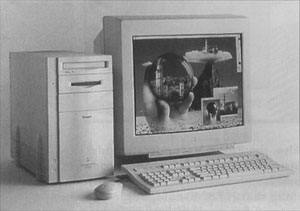 |
Power For the Rest of Us
Power Macintosh offers lightning speed and a host of questions. |
|
In 1984, the Macintosh 128K burst onto the computing scene. Well, okay, it crept onto the scene. The "computer for the rest of us" was a risky venture that could easily have fizzled. The world was ready for the Mac's graphical user interface; Apple just needed to explain that fact to the planet's unsuspecting inhabitants in an evangelical PR campaign. In the decade that followed, all Macs that ever lived were built around a single family of microprocessors, the Motorola 68000 and its descendants. But no more; the PowerPC chip has been born, and the 680x0 clan appears headed for the spare-parts bin. The product of a once-unthinkable alliance between Motorola, Apple, and IBM, the PowerPC family of high-speed microprocessor chips will be the brain of most Apple and IBM personal computers in the future. Apple, for one, is putting all its high-tech eggs in the PowerPC basket. In the midst of another evangelical PR campaign, the company is moving quickly to phase out most of its high- and mid-level 680x0-based Macs and almost certainly will phase out the rest of them in the next year or two. The Quadra AVs, 610, 650, and 800, will almost certainly be history in the near future. Of particular interest to musicians, the blazing speed of the PowerPC makes the new computers capable of recording and playing 16-bit digital audio without using a DSP coprocessor. As we'll see later, however, there appear to be several "ifs" and "buts" to this capability. Taking RISCs Motorola, Apple, and IBM believe that CISC technology has almost reached its performance peak. (Motorola is working on a 68060, however, and DayStar Digital will offer current Mac users a series of accelerators based on it.) Apple sources state that further integration of CISC chips will increase the size and heat output of the chip but provide only a minimal gain in speed. Instead of continuing down the CISC path, the partners decided to tap the power of an alternative chip architecture, Reduced Instruction Set Computing (RISC). The main difference between CISC and RISC is that instead of the wide variety of instructions contained in a CISC chip, a RISC: chip only contains the instructions used most often. However, it can execute these basic instructions extremely quickly. When complex instructions are required, the RISC chip builds them by combining sets of basic instructions. This means that most operations are handled far more rapidly in RISC than in CISC. (The hardware details of Power PC RISC chips were discussed in the March 1994 "Tech Page.") |
RISC chips of various types have been around a long time, powering various primarily UNIX-based, systems such as engineering workstations, high-end graphics machines, and large, commercial database servers. However, this constitutes a relatively small volume of expensive chips. Until the development of PowerPC, nobody marketed an affordable RISC chip that could run familiar operating systems such as Microsoft DOS and Windows and Apple System 7. In contrast, Motorola, Apple, and IBM are developing a full line of PowerPC chips and products for desktop computers, network servers, portables, workstations, and even consumer electronics. Welcome To Power Mac
In addition, UNIX fans should be able to run Power Open, a replacement for A/UX, sometime later this year. A Power Mac version of the Taligent operating system is also in the works. To top it off, Insignia Solutions is offering Soft Windows, which lets you run DOS and Windows applications on a Power Mac (see sidebar "Power Windows"). (IBM's as-yet-unreleased PowerPC computers also are expected to run several operating systems, with the primary focus on Windows NT and OS/2.) The first three Power Macintoshes off the line use the first-generation, 32-bit PowerPC 601 chip and replace the mid- to high-end Quadras. Early next year, the 601 chip will be joined by the low-power, low-heat PowerPC 603. The 32-bit 603, which is already in production, is a tad slower than the 601, so it probably won't obsolete the current crop of 601-based machines. Unlike the older chip, however, the 603 offers four software-controllable power-saving modes, including a dynamic mode that automatically puts inactive areas of the microprocessor in a low-power state. This makes it Apple's choice for portables, as well as LCs and Performas. |
Despite his title, Senior Editor Steve O is not an Ancient, nor does he only edit articles written by septuagenarians. He has, however, worked in EM's editorial department longer than any of these young whippersnappers. |
|
